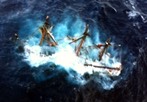Tried and true; A Recipe for Disaster
On Oct. 29, 2012, the 108-foot-long Bounty was destroyed by Hurricane Sandy’s 30-foot seas and 100-mph gusts, and it sank 123 miles off the coast of Cape Hatteras, North Carolina. One member of the 16-person crew, 42-year-old Claudene Christian, died in the incident, and the longtime captain, Robin Walbridge, 63, was never found. He was presumed dead. Another 14 crew members were saved by Coast Guard rescuers.
THE RECIPE

Capt. Walbridge, attempting to sail an unseaworthy Bounty from Connecticut to Florida, was trying to outflank Hurricane Sandy, which was roaring toward New York. But instead of slipping around the storm, the ship crossed directly into Sandy’s path.
...workers at the Boothbay Harbor Shipyard warned Bounty Capt. Robin Walbridge about rotting wooden planks on the ship and inadequate caulking done while the vessel was in Maine for maintenance just prior to its sinking, but that Walbridge said he couldn’t afford the full repairs.
The shipyard workers additionally expressed concerns over the three seam compounds Walbridge supplied for the caulking work, much of which was performed by comparatively inexperienced Bounty crew members. Walbridge chose the compounds because they were less expensive, overlooking the fact that they weren’t recommended for water immersion or marine environments.
Concerned that the rot was extensive beneath the surface, shipyard workers urged Walbridge to remove more planks to explore the extent of the problem, but the captain declined because of money and schedule worries. Walbridge only ordered the minimal replacement of rotted wood and called for other sections to be painted over.
“He knew there was decay in the planking and frames of the hull but did not know how extensive the problem was. … [A] Boothbay Harbor Shipyard employee testified that he had warned [Walbridge] to ‘pick and choose how he used the boat’ and to avoid heavy weather.”
The captain had an impetuous streak. In August, he told a TV reporter in Maine: “We chase hurricanes. You try and get up as close to the eye of it as you can, and you stay down in the southeast quadrant.”
Chief mate John Svendsen, 41, a Bounty veteran, told Walbridge that high seas and devastating winds were predicted; the captain said the Bounty would handle the hurricane just fine.
THE DISASTER

It was after dark on Oct. 28, and the three-mast vessel pitched and rolled in the Atlantic 90 miles off Cape Hatteras, its 16 crew members fighting to keep the ship afloat. The ship’s engineer was seasick and spitting up his medication. A deckhand had been tossed past the mainmast, breaking three ribs. The captain had been slammed against a cabin table, wrenching his back. He could barely walk.
“Heading out to sea under normal conditions requires that the hull be sound, vessel systems be tested and functional, and crew proficiency and readiness be at the highest level possible. When headed into a storm of Hurricane Sandy’s size and scope, logic dictates that the importance of vessel seaworthiness, vital system functionality and crew readiness would increase exponentially,” the Coast Guard officer said. “That being said, [Walbridge] clearly chose to chart a course directly in the path and vicinity of Hurricane Sandy knowing all of the defects listed above.”
Around 3 a.m., the captain called everyone together on the tween deck. Walbridge was fond of what he called brainstorming, in which the entire crew chewed over a problem. He asked: “At what point did we lose control?”
As the crew helped one another into the survival suits, chief mate Svendsen tried twice to convince the captain to make the call to abandon ship. Walbridge refused... Sometime before 4 a.m., with the ship listing at a 45-degree angle, he changed his mind.
“We gotta go!” the captain hollered....Moments later, the Bounty was struck by a massive wave. The ship heaved abruptly starboard, dumping most of the crew into the Atlantic. Others jumped in as the ship began to slip under the waves.
Walbridge and Christian were missing.
Christian was last seen by the third mate as he held her hand on deck and passed her to another crewman just before the ship rolled. He remembered that she was calm and smiling.
The Coast Guard found Christian’s body later that day, about a mile from where the ship went down. Her first paycheck had not been cashed.
Walbridge was never found.
The 100-page Coast Guard report, based on an investigation by Cmdr. Kevin Carroll, included similar findings to those in a National Transportation Safety Board review released in February.
Tail wags to Stars and Stripes:
How the HMS Bounty fought Sandy, and lost
Coast Guard finds ill-fated Bounty avoided tighter safety standards, repair warnings
/fl
